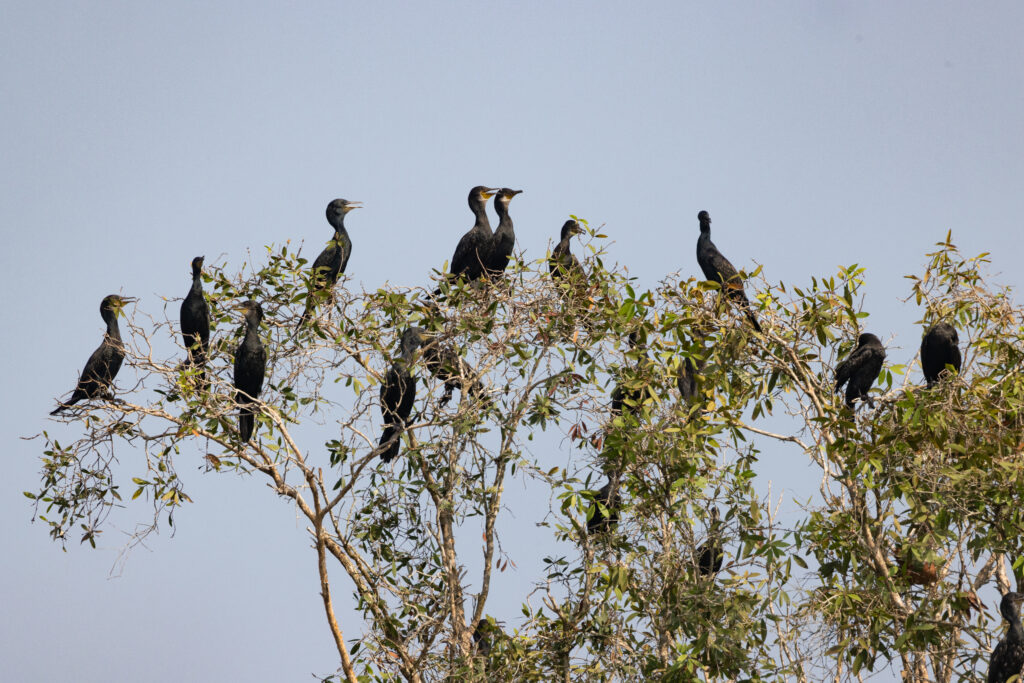WE arrived early at Tan Son Nhat International Airport in Ho Chi Minh City, formerly Saigon. I asked Gemini, Google’s AI model, about the origin of the name Tan Son Nhat, wanting to know if it was a heroic name. It said it is a village name and its origin was most likely derived from the Khmer words “Tân” (meaning “field”) and “Sơn Nhất” (meaning “first mountain”). This would refer to the fact that the area was once a rice field at the foot of a mountain.
Saigon, on the other hand, was popularized by the French in the late 1800s. France occupied Vietnam for six decades. Gemini said the name may either have come from Vietnamese characters “sài” (meaning “firewood”) and ” gòn” (meaning “cottonwood trees”), or from the Khmer term “Tay ngon” (meaning “tribute from the west.)” When the Vietnam War ended in 1975, the country was reunified under communist rule. In honor of Ho Chi Minh, the revolutionary leader who played a key role in Vietnam’s independence, Saigon was officially renamed Ho Chi Minh City on July 2, 1976.
Vietnam was divided by the Geneva Accords in 1954 after the French was defeated by the Vietnamese. The country was divided at the 17th parallel, with North Vietnam ruled by the communist Viet Minh and South Vietnam led by a US-backed government. By 1965, the US became deeply involved in the war with large-scale deployment of U.S. ground troops. But Vietnam defeated the Americans in 1975 with the fall of Saigon.
We have just returned from the 1st Vietnam Bird Race.
It was organized by Vietnamese ornithologist Nguyen Hoai Bao, who also heads the Vietnam Wildlife Photography Club, Wildtour Co. Ltd, and the Wild Bird Hotel which are behind the bird race.
Twenty teams took part in the race – including two teams from Malaysia, one team from the Philippines, one team from Cambodia, and two individual photographers from Peru and Norway who joined the Vietnamese teams. Some 77 bird photographers and birdwatchers, including 17 foreigners, made up the participating teams. We represented the Wild Bird Photographers of the Philippines (WBPP) and adopted the name Team Pilipinas.

My teammates were in Vietnam for the first time. For me, it was the second visit.
I visited Vietnam when I attended the APEC High-Level Policy Dialogue on Human Resources Development in the Digital Age on May 15-16, 2017 in Hanoi as Undersecretary of the Department of Education. I entered Vietnam unofficially three days before the conference to take advantage of the weekend and catch a quick birding before the official events, but the government was able to track me down as I was birding in Cuc Phuong National Park in Ninh Bình Province.
While waiting for the check-in counter to open, we came across an interesting article from Tuoi Tre, one of the most widely read newspapers in Vietnam, about the 1st Vietnam Bird Race we had just participated in. It was written in Vietnamese, so we asked Google to translate it.
The author, Mr. Huy Tho, gave this report, which piqued our interest:
“The most impressive thing is the foreign teams. Although they are guests, more or less unfamiliar with the terrain, they are very professional.
For example, on the morning of May 11, I went on a boat with the Philippine team, they had a clear strategy, the person using the 600mm telephoto (plus the 1.4x adapter, resulting in a focal length of 840mm) at the bow of the boat, two people using the 100-400mm lens flexibly and one person specializing in binoculars to find birds and guide their teammates to shoot.
The Philippine team leader, Mr. Goel L. Lamela, 64 years old this year, said: “We have been participating in competitions like this for over 20 years, so we are used to it”!
After landing at Tan Son Nhat airport, this team immediately moved to Tram Chim and hired a boat to survey the terrain and come up with a very specific plan.
Mr. Goel also said that Bird Race is a game that not only serves those who love to photograph and watch wild birds today, but also takes care of the future generation, with a variety of activities.”
We laughed and joked with Loel, who was mistakenly quoted as Goel, about the report’s mention of his alleged 20-year experience in bird races. He said he never mentioned that. His first bird race was only about 6 or 7 years ago at the 2017 Palawan Bird Photography Race.

But we are amazed at the author’s keen observation. He was on the boat with us and we did not know he was a reporter covering the bird race. He was actually right in his description of our movements.
When we arrived at the airport at 12:25 am on May 10 and after clearing with Immigration and Customs, we drove straight to Tram Chim National Park in Dong Thap province, the venue of the bird race, which is about 147 kilometers away. We arrived at the Wild Bird Hotel at around 5:00 am. We were supposed to wait for the bus that the organizers provided for all foreign delegates at 1:00 pm, but we decided to forgo this generous offer and drive earlier to the venue instead. The best way to spend the 10-12 hours of waiting time is birding, even if we have to spend a bit more money for the private ride.
We thought we would be the first participants to arrive at the venue, but to our surprise some Vietnamese birdwatchers were already having breakfast in the hotel’s restaurant waiting for their boat rides. They were a few minutes ahead of us while we were still unpacking, setting up our camera gear, and then quickly grabbing breakfast.
The team spent the whole morning in the boat, not surveying for the race, but rather getting quality shots of birds that we would not be able to do during the race. The race is primarily about taking more photos of birds, not about taking good photos. But the morning boat ride already gave us a clear overview of the entire wetland, a national park in the Plain of Reeds in the Mekong Delta region of Vietnam. The park was established to restore a degraded wetland and protect several rare birds, in particular the Sarus Crane — a species on the International Union for the Conservation of Nature (IUCN) Red List.
I was quite disappointed that we could not see or photograph the Sarus Cranes which, we later learned, have become a rare sight because the water level in the park is quite high. Sarus Cranes prefer shallow wetlands where they can easily reach food sources with their long legs and beaks.
Sarus Cranes once foraged in the wetlands of the Philippines. Christian Perez wrote in an article titled “The Sarus Crane Illustrated 1847” in eBON, the official online magazine of Wild Bird Club of the Philippines (WBCP):
“American Ornithologist Richard McGregor called it (Sarus Crane) Sharpe’s Crane and reported in 1909 that it “is abundant in the vicinity of Cabanatuan, Nueva Ecija”. He adds that this species has been reported from the Candaba Swamp in central Luzon and Worcester found it abundant in northern Luzon. He says: “I saw Antigone sharpei in large numbers in Cagayan and Isabela during my recent trip, 1906, through those provinces. I am informed that these birds nest on the ground in May, contenting themselves with scraping together and flattening down a little grass on which to deposit their eggs. About August they lose their long wing-feathers and when in this conditions can rise but a few feet from the ground. The people of Isabela then pursue them on horseback and take them with lassos, although according to the statements of the hunters the birds, aided by their wings, run about as fast as deer.
Edward Dickinson in 1991 says “probably extirpated”. Robert Kennedy in 2000 also says “rare, perhaps extirpated.” It seems that these authors were not 100 percent sure and did not want to commit in writing that the Sarus Crane was gone from the Philippines. Present day birders know that it is impossible to imagine that the Sarus Crane might still be hiding somewhere in Luzon and that it is definitely extirpated, as stated in the WBCP 2016 Checklist.”
Source: https://ebonph.wordpress.com/2016/12/31/the-history-corner-the-sarus-crane-illustrated-in-1847/
My photos of the Sarus Cranes, which were once on display at the National Museum of the Philippines along with a taxidermy bird, were taken in Cambodia.

The boat trip that morning also showed us how hot it can get from 10am to noon. So, the first thing on our to-do list for the race was to get ourselves an ice bucket full of ice with our water bottles in it to quench our thirst, and wet face towels from the hotel so we could always put them on our napes, necks, faces, and arms to cool us down. That actually gave us the comfort we needed during those extremely hot hours.
During the race, we discovered another way to cool down. We soaked our multifunction neck tube in ice cold water and wore them so that they covered our entire heads and only showed our faces. This neck tube, also called neck gaiter, can be worn as a face mask, headband, or beanie. Neck gaiters soaked in ice cold water was much better than the cold towels. It was as if our heads were filled with cool air. I wondered why the journalist, Mr. Huy Tho, was unable to account this small but very helpful innovation, even though we saw him take an ice-cold water bottle out of the water bucket and replace it with the warm one from the box.
Mr. Huy Tho was precise when he described our positioning and strategy. Two of us, Loel Lamela (WBPP trustee) and Djop Tabaranza (WBPP treasurer), were positioned at the rear bow. They had the task of photographing birds that were more than 50 meters away. Loel had a 600mm lens. He added a 2x teleconverter to extend his range to 1,200mm, and then added another 2x teleconverter to increase the range to 2,400mm. I even asked him how to add two 2x teleconverters. When I tried the same technique when I photographed the Philippine Eagle in Mt. Apo in 2014, I could not achieve that with the same brand of teleconverters. I could only add a 2x and a 1.4x when they belong to different brands like Canon and Kenko. He said he uses the same Canon brand teleconverter but in different versions, one is version II and the other III.
Prof. Bert Madrigal (WBPP secretary) and I were positioned at the front bow and were specifically tasked with photographing birds less than 50 meters away. Therefore, I used my 100-500mm lens, while Prof. Bert used the 400mm f/5.6, which we both held in our hands to be flexible and handy.
Djop and I used Optisan binoculars and scouted the areas with birds. Haring Ibon-Birds in Focus distributes Optisan optics in the Philippines. The clarity of the binocs really help us identify birds at far places. We were also tasked to identify birds and describe their locations to our teammates. Our targets were sandpipers and plovers, which we thought would tilt the balance in our favor. Unfortunately, we could not find these migratory birds that usually congregate in wetlands. Perhaps they had already left as the migration season has come to an end. Which kept me wondering why the bird race was done at the tail end of the migration season and not at its peak.
One limitation we experienced was communication with the boatman. We could not understand each other because of the language barrier. We had already experienced this on our previous boat trip the day before. Apart from the language barrier, the skipper could not hear our knocking on the bow or our shouts to slow down. He only responded when our calls were loud enough. Understandably, he was sitting right next to the boat’s noisy engine. Our supposed solution was to take a rope to tie on his arms so that we could get his attention. But we could not do that because we were told that we were not allowed to stop the boat driver. Each boat driver had his own schedule and would stop only in specific areas as planned by the organizer. We understood this during the briefing, but it turned out that we could still instruct the boat driver. A case of “lost in translation”.
After the morning boat trip, Loel, Djop, and Prof. Bert birded in various areas near the Wild Bird Hotel. I stayed back at the restaurant to finalize a presentation I would be giving to the participants in the evening – an introduction to Philippine birds, the three major events happening in the Philippines this year, and the various birding tour packages offered by Bird Finder Philippines, of which we also belong.
The next morning, from 5:30am to 8:30am, we all birded separately in different areas near the Wild Bird Hotel. We spent the last 30 minutes finalizing our bird list, although we had already done our initial listing and tallying of photos the night before. We counted 65 that night, we would want to get ten more the next day. This was spent over Saigon Beers in the company of Cambodian friends who had decided to drop off the race and instead go the next day to Nam Cat Tien, a tropical forest park in Vietnam, as they were not in a position to photograph birds. They thought that spotting or sighting and listing them would be enough for the race. Another case of “lost in translation”.

We also did not submit any photos for the best photo competition. We thought that only migratory birds in action would qualify, but it turns out that any bird or all birds in action can be submitted.
Once again, another case of “lost in translation”. But even if we did submit, we could not beat the photo of Pham Trung Kien of Pied Kingfishers, the parent feeding the young in mid-air.
For the next Bird Race, we would suggest that school or college students who are already fluent in English be assigned as translators or liaison officers for the international teams to ensure that nothing is lost in translation and to facilitate communication with the boatmen, hotel and restaurant staff, and delegates amongst themselves. These students would also learn from foreign delegates of things they would want to ask or are curious about.
WBPP Team Pilipinas photographed around 68 species, making it at fourth place. Our team was only 1 point behind Vietnamese team, Spot-billed Pelican, who scored 69 points and took third place. Second place went to Vietnamese team Bengal Florican with 70 bird species, and the winner was Vietnamese team Brown Bobby with 71 bird species. It looked like all four teams would be tied with a very small margin. WBPP Team Pilipinas was the only foreign team to win the very close bird race.
Interestingly, the local Vietnamese teams adopted the names of birds as the names for their teams. We chose WBPP as Team Pilipinas to emphasize our country of origin. It is better to have Team Malaysia, Team Cambodia, Team Sabah Malaysia (if more than one team is from the same country) etc. as names for foreign teams to emphasize the internationality of the competition.
It is good to note that Mr. Bao engaged Mr. Henry Goh of Malaysia’s Fraser’s Hill International Bird Race to invite and coordinate/facilitate the participation of international birders. He tapped Mr. Goh’s expertise and experience to help organize the 1st bird race in Vietnam. The Fraser’s Hill International Bird race is the oldest bird race in Malaysia, probably in Asia too. It will have its 35th event on June 7-9, 2024. It was Mr. Goh who contacted the WBPP to participate in the 1st Vietnam Bird Race, albeit at very short notice, which we were happy to join.
The 68 species we photographed are: Asian Green Bee-eater, Asian Koel, Asian Openbill, Black Bittern, Black-crowned Night-heron, Black-headed Ibis, Black-winged Kite, Black-winged Stilt, Blue-throated Bee-eater, Bronze-winged Jacana, Brown-throated Sunbird, Cattle Egret, Chestnut Munia, Chestnut-tailed Starling, Chinese Pond Heron, Cinnamon Bittern, Collared Kingfisher, Common Iora, Common Moorhen, Common Myna, Common Tailorbird, Coppersmith Barbet, Cotton Pygmy Goose, Eurasian Tree Sparrow, Freckle-breasted Woodpecker, Germains Swift, Glossy Ibis, Golden-bellied Gerygone, Great Cormorant, Great Egret, Greater Coucal, Grey-headed Swamphen, Grey Heron, House Sparrow, Indian Cormorant, Indian Spot-billed Duck, Intermediate Egret, Lesser Whistling Duck, Little Cormorant, Little Egret, Little Grebe, Malaysian Pied Fantail, Oriental Darter,l Oriental Magpie-Robin, Oriental Pratincole, Oriental Reed Warbler, Ornate Sunbird, Paddyfield Pipit, Painted Stork, Pied Kingfisher, Pink-necked Green Pigeon, Plain Prinia, Plaintive Cuckoo, Purple Heron, Racket-tail Treepie, Red Collared Dove, Scaly-breasted Munia, Scarlet-backed Flowerpecker, Spotted Dove, Streak-eared Bulbul, Striated Grassbird, Striated Swallow, White-breasted Waterhen, White-rumped Munia, Yellow Bittern, Yellow-bellied Prinia, Yellow-vented Bulbul, and Zebra Dove.
We missed 3 species – the Large Scimitar Babbler that we saw near the restaurant when we arrived but was nowhere to be seen during the actual race, as well as a species of Skylark and the Black-capped Kingfisher, that we were not able to photograph. We also missed the Collared Scops Owl and the Large-tailed Nightjar as we had not gone owling the night before, preferring to note down the day’s catch over some beers. We also missed the Spotted-billed Pelican, Comb Duck, Spoon-billed Duck or Northern Shoveler, and others seen by the winning teams.
The Vietnam Bird Race is quite unique as all participants have to search for birds in the wetlands by boat, at least that was mandatory in the morning. In the Palawan Bird Race, service vans drive the participating teams through Puerto Princesa City, while in the Fraser’s Hill Bird Race and the Sabah Bird Race, all participants walk through the birding areas, though not as wide as an entire city like Puerto Princesa or an entire wetland park like Tram Chin.
The highlight of this competition was the appearance of two migratory bird species, the Comb Duck and the Northern Shoveler, an extremely rare sighting and a positive sign that Tram Chim is recovering well.
The Vietnam Bird Race is also excellent in three more ways.
Firstly, a workshop was held for children and young students on painting by Dao Van Hoang. The children and students were then asked to make their own watercolor paintings with the photos of Vietnamese bird photographers as models or references. The race delegates and some guests later judged the students’ works, each receiving a sticker to put on the artworks they thought were outstanding and excellent. But it did not stop there. The top 8 works of the students who received the most stickers were auctioned off during the award and closing ceremony for a total of 27 million dong. A representative from Canon donated another 3 million, and photographer Doan Như Hoan – nicknamed Bay Hoang Da – donated 20 million to round up the 50 million (USD 2,000; PhP 114,000). The proceeds were donated to the Tam Nong Education Department for scholarships. The campaign interestingly combined the best bird photos, children learning to draw and actually drawing birds, and their works used to raise money for education. This is wildlife awareness, conservation initiative, and support for education all in one.
The lecturer and facilitator in the painting workshop for kids, Dao Van Hoang, was with us on the bus ride back to Ho Chi Minh. He approached me as he is very interested to see the Philippine Eagle, and then we conversed and tried to learn something from each other. I learned he left Vietnam by boat, as a refugee, four years after the war ended in 1975, and settled in France. He returned in Vietnam in 1996 and is now a fulltime wildlife painter.
Secondly, the organizers offered a workshop in the evening where any interested delegate or team can share or present something to all participants and local organizers and guests. Malaysia presented the newly renovated Utan Lodge in Sandakan, Sabah, that also features a bird hide. Mr. Bao, the head of the organizing committee, together with Mr. Yong Ding Li from Birdlife Asia, presented the Spoon-billed Sandpiper. I introduced Philippine birds, the three major birding events in 2024, and the Bird Finder Philippines travel packages. The major Philippine birding events are the Subic Bay 1st International Photomarathon (Birds, Wildlife, Landscape) scheduled on August 30 to September 1, 2024; the 7th Puerto Princesa Underground River International Birding Festival in Palawan from November 17 to 19, 2024; and the 13th Asian Bird Fair in Las Pinas, Metro Manila from November 20to 23, 2024.
And thirdly, there was a fun contest about the rarest bird photo. Each team was asked to submit a photo of a species they believe they were the only ones who have photographed. It was fun to know that one’s claim can easily be disputed, albeit in a boastful yet friendly way by the others. The winner, a local team, won five cases of Saigon beer which they shared with everyone.
The evening workshops and the rarest bird photo contest were excellent activities to strengthen friendship, solidarity, and camaraderie among birders, both local and foreign, who participated in the race. This is what I always look for in international birding events – the opportunity and time to interact and establish friendships with fellow birders.
I recall what Noah Strycker wrote in his book “Birding Without Borders – An Obsession, A Quest, and The Biggest Year in the World”:
“This is what birding is all about – people with a shared passion, sometimes from entirely different continents and maybe not even speaking the same language, meeting as strangers, joining in a common goal, and becoming the best of friends.”
We felt very comfortable in Vietnam and with the Vietnamese. We know that Filipino involvement in the Vietnam War was not in combat. Gemini said Filipino medical personnel were sent to assist Vietnamese refugees as early as 1954. Throughout the war, the Philippines deployed over 10,000 troops. However, they were not combat troops. They operated under the name Philippine Civic Action Group-Vietnam (PHILCAG-V) and focused on medical care, infrastructure development and other civilian projects in South Vietnam. Nevertheless, we suffered losses. About nine Filipinos lost their lives in Vietnam. There is no official information on the cause of death, but we know that they were mistaken for Vietnamese. Our loss is just a blip compared to millions of Vietnamese deaths.
Gemini further said that the US did not launch direct combat operations from the Philippines at the time due to growing anti-war sentiment and concern for Philippine sovereignty. The US military bases in the Philippines were used for logistical support rather than direct combat operations, more specifically as a staging area and supply depot, for rest and recuperation, and for communications and intelligence gathering.
In 1991, the Philippine Senate rejected a treaty that would have extended the US military presence beyond the expiration of the 1947 Military Bases Agreement, which would have granted the US access to Philippine bases for 99 years.
One of those turned-over bases is now Subic Bay Freeport Zone, and it hosts the Subic Bay Rainforest where about 213 bird species have been recorded, 83 of which are Philippine endemics (21 are endemic to Luzon Island).
Subic Bay Freeport Zone is the venue of the Subic Bay 1st International Photomarathon (Birds, Wildlife, Landscape) scheduled on August 30 to September 1, 2024.
Despite the lack of government support, the success of the 1st Vietnam Bird Race is a testament to the dedication of the organizers. We extend our sincerest gratitude to Mr. Bao, the Vietnam Wildlife Photography Club, Widltour Co. Ltd., and the Wild Bird Hotel for their competence and generosity.
***
Alain Pascua is the co-founder and president of the Wild Bird Photographers of the Philippines, member of the Wild Bird Club of the Philippines, and author of Haring Ibon: The Great Philippine Eagle book and co-author of Endangered Bird Species of the Philippines book. He served as Undersecretary of the Department of Education of the Republic of the Philippines from 2016 to 2022.





